Chemtrails or Contrails?
By Roy W. Spencer, Ph.D.
May 1, 2025
Cirrus clouds have been around forever. Cloud types were first named by English pharmacist Luke Howard in 1802 using Latin terms. Cirrus clouds refer to their hair-like appearance, but they can take on many shapes depending upon conditions such as humidity, the rate at which air is rising, and changes of wind speed and direction with height.
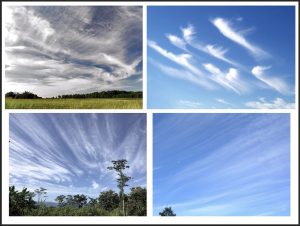
Fig. 1. Various types of naturally forming cirrus clouds (from Wikipedia, https://en.wikipedia.org/wiki/Cirrus_cloud)
Cirrus clouds were even imaged on Neptune during Voyager 2’s flyby in 1989 (Fig. 2) showing they are not unique to Earth.
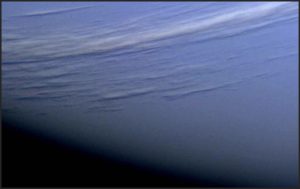
Fig. 2. Cirrus clouds over Neptune, imaged by Voyager 2 in 1989 (NASA).
As early as 1918 it was noticed that aircraft which fly at sufficiently high altitudes produce trails of water vapor which are often converted to cirrus clouds (Baucom, 2007a). These are called condensation trails (contrails). Heymsfield et al. (2010) provided a concise survey of what was understood about contrail formation at that time. A more recent survey article (Singh et al., 2024) summarizes many years of research into how contrails form as well as their estimated warming impact on climate.
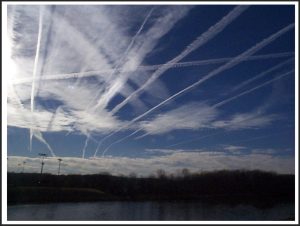
Fig. 3. Jet contrails above natural altocumulus clouds (Wikipedia, https://en.wikipedia.org/wiki/Contrail)
The Chemistry
Clouds, whether composed of water or ice, require water vapor for their formation. The source of the water vapor for contrail formation is from burning jet fuel, which (like gasoline) is oxidized during combustion. Most people are surprised to learn that burning 1 kilogram (kg) of jet fuel produces even more (1.23 kg) of water vapor (and 3.16 kg of CO2), due to oxygen in the atmosphere combining with some of the hydrogen in the fuel to produce water (H2O) and carbon in the fuel to produce CO2. The chemistry of this process has been well understood for many decades. Because of the complex chemistry of jet fuel, there are also a number of other compounds produced during combustion. Soot particles act as the primary condensation nuclei for cloud water, and those droplets then freeze into ice particles, producing jet contrail cirrus clouds. (Natural cirrus clouds form on naturally occurring condensation nuclei which are always present in the atmosphere.)
There are research efforts to reduce jet contrail formation using alternative fuel formulations and different engine designs. For instance, reducing soot particles reduces the number of contrail ice particles formed. But even if soot were eliminated, there are H2SO4 (sulfuric acid) aerosols produced during combustion that can also act as condensation nuclei for contrail formation.
The Meteorology
Part of the public alarm over contrails (now called “chemtrails” by some) is partly because their appearance varies a lot from day to day. One day there can be a clear blue sky, and the next day the sky is filled with jet contrails. If someone does not understand why there are such large changes from one day to the next, they can become alarmed. But the reasons for this are well understood and are the same reasons why one day can have clear skies and the next day overcast clouds.
The first algorithm for determining whether weather conditions will support jet contrail formation was described by Appleman (1953), a method that has been used for many years by the Air Force to aide in flight planning for stealth purposes, which are confounded by contrails indicating the existence of aircraft. From a meteorological perspective, whether ice clouds form behind jet aircraft depends upon the relative humidity of the high-altitude air where jets routinely fly and how cold the air is. At high altitudes where air is often -40 degrees F or colder, if the relative humidity is high (say, over 90%), contrails can form, grow, and persist for many hours. If the humidity is very low (say, below 20%), contrails won’t form because the high-humidity air exiting the jet engines is rapidly mixed with dry environmental air through turbulence created by the jet exhaust.
Varying weather conditions lead to dramatic variations in contrail appearance. As the above images show, cirrus clouds (whether natural or jet-produced) tend to have edges, beginnings and ends. This is why jet contrails can appear, disappear, and reappear behind a jet in a matter of seconds, depending upon the humidity of the air through which the jet is flying.
Why are jet contrails so striking in appearance? It’s because the water produced through the combustion of jet fuel is often much more than the exceedingly cold air at jet-cruising altitudes can hold without condensation occurring. Near the ground, where the air is warmer, cars and trucks produce much more water vapor than jets do. But we don’t see “car trails” because the air at ground level can hold much more water vapor without condensation occurring. Only on very cold mornings, or at relative humidities near 100%, do we see condensation trailing from vehicle tailpipes. This is why jet-produced cirrus clouds are so abundant, even though aviation only uses a few percent of all global liquid fuels.
The following NASA satellite image from 29 January 2004 shows widespread contrail activity over the Southeast U.S. in a region where high humidity air at high altitudes is also producing natural cirrostratus clouds. But farther north where the air is drier, no contrails form. This is why some people are alarmed by days when contrails fill the skies, while on other days the blue sky remains cloud-free. This is well understood from a meteorological perspective
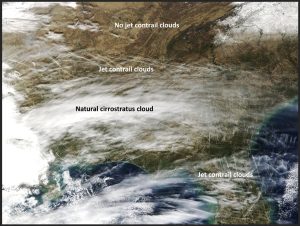
Fig. 4. NASA MODIS imagery of natural and aircraft-produced clouds over the Southeast U.S. on 29 January 2004.
Scientific studies of contrails extend back at least to the 1970s (which is when I was studying meteorology in college), with instrumented aircraft flying through the contrails to sample the sizes and abundance of the ice crystals (Heymsfield et al., 2010). One of the interesting findings was that there was often more ice mass contained in some of the contrails than could be accounted for by the chemistry of combustion alone. This is because ice particles in a high humidity environment scavenge water vapor from the air as the ice crystals grow. This is the same process through which a lot of precipitation forms in the upper atmosphere. This explains why some contrails will continue to grow for several hours after the aircraft producing them have long since left the area. Environmental humidity condenses on the jet contrail ice particles, causing them to grow in size and abundance.
More Aviation Means More Contrails
As noticed by many citizens, contrails have increased over the decades. This is because jet fuel use has increased dramatically since the 1940s. While the following plot shows the production of CO2 by aviation, the corresponding plot for water vapor would look exactly same, but the vertical scale values would have to be divided by 2.57 (because water vapor and CO2 production are directly proportional to fuel use, by the chemistry-based values stated above).
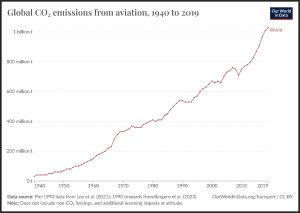
Fig. 5. Yearly estimated CO2 emissions from aviation, 1940 to 2019. (Ourworldindata.org)
In that plot there were relatively few aviation emissions in the early years. But even in World War II (1940 to 1945), fighter aircraft involved in dogfights (and anti-aircraft gunners on the ground) in the European theater learned to use contrails to locate aircraft that might be too high or too far away to identify visually. The following photos from WWII show contrails from both bombers and fighter jets.
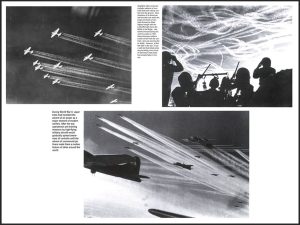
Fig. 6. Contrails from bombers and fighter aircraft in WWII (Baucom, 2007b).
In his book Flying the SR-71 Blackbird: In the Cockpit on a Secret Operational Mission, Air Force pilot Richard Graham discussed the importance of avoiding the production of contrails to maintain stealth, which depended upon local atmospheric conditions:
“Jet aircraft generally will not produce a contrail above 50,000 feet. On one particular Barents Sea mission, my plane was putting out a highly visible contrail at 72,000 feet. When I looked in my rear-view periscope, I couldn’t believe it was possible, but there it was! Fortunately, the contrail stopped before I entered the sensitive area; otherwise, I would have had to abort the mission.”
Today the skies are filled with jet aircraft. There are websites where you can see, in real time, where aircraft are operating anywhere in the world. If you see a contrail overhead as it is being formed, you can use such websites to see which aircraft is producing the contrail; almost always it will be a commercial jet transporting passengers. But because air traffic has increased dramatically, so have contrails, which has led to alarm among some people who consider them to be unnatural. And they are indeed “unnatural” in the sense that they would not exist without aviation.
Google has developed an algorithm to identify jet contrails from weather satellite imagery in near-real time. The website (https://contrails.webapps.google.com) also includes a nice video explaining contrail formation and a test project with American Airlines where commercial airline pilots change altitude to reduce contrail formation.
Chemtrail Claims
The increase in air traffic has led to the popularization of chemtrail theories, which usually involve claims that damaging chemicals are being sprayed by aircraft. Possibly the most influential purveyor of the chemtrail theory is Dale Wigington who runs the Geoengineering Watch website. His claims have been expanded over the years to include all kinds of weather influences supposedly caused by secret government operations, including even California droughts.
These chemtrail claims will often invoke contrail features that people cannot easily explain. As mentioned above, cirrus clouds (whether natural or manmade) can take on myriad shapes, depending upon the strength of rising air currents, relative humidity, and changes in wind speed and direction with height (wind shear). Thus, contrails broken up into segments might look like the result of chemical spraying as it is being turned on and off, but the intermittent nature of contrail formation is no different from the intermittent nature of natural cirrus clouds seen above in Fig. 1.
Regarding “chemtrails”, Grok 3 (accessed 4/25/25) says,
“Chemtrail conspiracy theories first gained traction in the mid-1990s, particularly around 1996… A key catalyst was a 1996 U.S. Air Force research paper titled Weather as a Force Multiplier: Owning the Weather in 2025, which discussed speculative weather modification technologies. Though theoretical, the paper was misinterpreted by some as evidence of secret government programs.”
I have read that report (written by Air Force academy students), and indeed it was highly speculative. It did not mention any existing cloud- or weather-modification technologies beyond the usual cloud-seeding efforts which date back to the 1950s. Cloud seeding is real, but it is seldom utilized because there has been little evidence that it increases a cloud’s ability to precipitate, except under special circumstances. A review of such precipitation enhancement, including doubts about its effectiveness, was provided by Flossmann et al. (2019).
Scattered (and largely unsuccessful) cloud seeding attempts were meant to get clouds to precipitate before they were ready to and were used almost exclusively in rather dry regions or seasons where more precipitation was desired. Cloud seeding continues today in many countries that can afford this largely unproven technology. The fact that the Air Force report was unclassified should indicate that there was nothing nefarious contained in it.
Are There Chemicals in Contrails?
Are there chemical constituents in jet contrails that would justify calling them “chemtrails”? Well, there are other byproducts of jet fuel combustion, just like there are from gasoline combustion, such as carbon monoxide (CO), nitrogen oxides (NOx), hydrocarbons, sulfur dioxide (SO2) and soot. So, I suppose you could call contrails “chemtrails” in the sense that they contain chemical byproducts of fuel combustion. Even water is a chemical.
But chemtrail theories would not exist if not for the appearance of ice-water clouds, which are known to form behind jet aircraft, simply as a necessary and unavoidable consequence of the burning of jet fuel.
What people see in the sky are just cirrus clouds. Are they more abundant today than, say, 50 years ago? Yes, because air traffic has increased dramatically.
Do they contain other chemicals? Yes, because there are many byproducts of burning petroleum-based fuels.
But do they represent chemical spraying operations? In my 40+ years of cloud watching and meteorological and climate research, I have seen nothing to support that claim.
But Isn’t Weather Modification a Real Thing?
Yes, weather modification is real, and it has a long history. There was even an Advisory Committee on Weather Control, established by an act of the U.S. Congress in 1953!
But little in the way of “control” was ever accomplished. For example, a review paper published in 1963 (Huschke, 1963) surveyed the published results of weather modification efforts that occurred since 1946. The term “weather modification” almost always means the seeding of a cloud by aircraft with either dry ice, silver iodide, or some other chemical that will stimulate precipitation production by the cloud. Rarely, it can mean efforts to suppress hail formation. It is a very isolated, special purpose activity that has had only limited success (if any at all), partly because it is difficult to get a cloud to produce rain unless it is ready to do so anyway. It is difficult to fool Mother Nature.
Are Jet Contrails Geoengineering?
Geoengineering has a specific meaning to climate researchers like me: It usually refers to the proposed, purposeful production of sulfate aerosols in the stratosphere (higher than most jet aircraft can fly), where the aerosols reflect a small fraction of incoming sunlight back to space, thus helping to reduce global temperatures (Smith et al., 2018). Unfortunately, chemtrail theorists have conflated the production of contrails with purposeful geoengineering, which is not the case. Contrails are the (mostly) unavoidable result of burning liquid fuels at very low environmental temperatures and air pressures. As demonstrated above, it’s being going on for over a century.
Geoengineering proposals, in contrast, usually involve attempts to intentionally mimic what happened naturally after the 1991 eruption of Mt. Pinatubo in the Philippines. Mt. Pinatubo injected approximately 10 million tons of sulfur into the stratosphere, where it produced sulfuric acid aerosols that reduced sunlight by a global average of 2-4% for 1-2 years. The summer of 1992 was noticeably cooler over many Northern Hemisphere land areas. But no one complained about nefarious chemical spraying activities at the time, even though those 10 million tons of sulfuric acid aerosols were spread around the world by stratospheric winds and were responsible for milky-white skies nearly everywhere.
To accomplish anything close to what Pinatubo did (10 million tons of sulfate aerosols injected into the stratosphere) would require up to 1 million flights of specially designed aircraft capable of reaching altitudes of 60,000 feet or higher. This is not currently happening, and I doubt it will ever happen, due to public opposition. If it were happening, it would be impossible to keep that massive of an operation hidden. Isolated balloon experiments to release climate-altering aerosols have been reported, but they are minuscule and impotent. The resulting public outcry over them is misplaced.
By way of comparison, just in the U.S., the use of fossil fuels produces close to 2 million tons of SO2 emissions each year. And that’s into the air we breathe, not up in the stratosphere where it is isolated from human exposure like what happened after the 1991 Pinatubo eruption. Those U.S. SO2 emissions were over three times greater in 2011, but EPA regulations have reduced sulfate pollution a lot in recent years. So, publicized experiments to release aerosols by balloons are trivial in comparison to the normal daily SO2 emissions by cars and trucks.
But do jet contrails also alter the climate system through inadvertent geoengineering? There is a public perception that they reduce sunlight, which is true to some small extent over the limited regions with heavy air traffic. Remember that jets fly over areas where most people live, and so humans get a distorted perspective of global coverage by contrails, which has been estimated to be about one-quarter of one percent. But contrails also reduce the infrared cooling rate of the climate system, which is a warming influence. In fact, it is now widely agreed that the warming effect predominates over the sunlight reflection (cooling) effect, although it remains small and largely regional in extent (Smith et al, 2018). Nevertheless, some researchers claim that jet contrails represent a non-negligible (but still small) component of anthropogenic global warming.
Other Aircraft-Related Phenomena
Sometimes there are cloud-like features associated with flying aircraft that are also considered to be evidence of chemtrails. Rarely, aircraft will dump fuel out of valves away from the engines or near the wingtips, but this is unusual. Also, various liquid-cloud features can briefly form over wings or other surfaces when the humidity is very high at low altitudes. This occurs where the air pressure is lowered over the plane’s aerodynamic surfaces, causing slight cooling and then condensation of water vapor into a temporary cloud. Anyone who flies regularly and looks out the window has seen this effect.
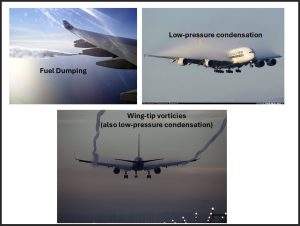
Fig. 7. Various aircraft-related phenomena sometimes cited as evidence of chemical spraying.
The Role of Social Media
Before the internet and social media, there were still jet contrails, and people generally understood what caused them. No one was concerned.
But in recent years people have become more willing to believe claims that come from untrustworthy sources and then spread those claims. For example, I was recently emailed an article from a website called The Peoples Voice which claimed (along with photos) that President Trump’s “Chemtrail Task Force” had arrested pilots who had engaged in illegal chemtrail spraying.
Except there is no Chemtrail Task Force, and there were no such arrests.
I’m not claiming that all such alternative news reporting is without merit. I’m objecting to uninformed “chemtrail” claims.
I also fear that our educational systems have spent too much time teaching students what to think rather than how to think. I am continually amazed at the chemtrail claims and photos posted on X (formerly Twitter). Some of the photos aren’t even of jet contrails; they are simply natural cirrus cloud formations. It’s as if people never looked at the sky until recently and so have no idea what they are seeing.
The Bottom Line
There is no evidence that the cloud trails behind aircraft are anything more than what we have known for over a century: condensation trails of cirrus (ice) clouds unavoidably resulting from the combustion of liquid fuels. That combustion produces soot (acting as cloud condensation nuclei) and large amounts of water vapor to condense into cloud particles.
Methods for predicting weather conditions conducive to contrail formation have been in use since the 1950s. Research flights into contrails to study their formation and what they are composed of have been carried out many times, and nothing sinister or nefarious has ever been reported. The reasons for skies being clear blue on one day and filled with contrails the next are similar to the reasons why natural clouds exist on some days but not other days: cloud formation is controlled by natural variations in relative humidity. Contrails can start and stop for the same reason natural cirrus clouds start and stop.
Nevertheless, increasing aviation activity has led to more contrails, leading to citizens noticing contrails more than ever before. Public alarm has been amplified by the spread of false information regarding “chemtrails” on social media combined with a general distrust in the government.
But not everything we see and are concerned about is necessarily the result of a government conspiracy.
Dr. Spencer received his M.S. and Ph.D. in Meteorology from the University of Wisconsin in 1980 and 1982. He then continued at the University of Wisconsin through 1984 in the Space Science and Engineering Center as a research scientist. He joined NASA’s Marshall Space Flight Center (MSFC) in 1984, where he later became Senior Scientist for Climate Studies. He resigned from NASA in 2001 and joined the Univeristy of Alabama in Huntsville as a Principal Research Scientist.
Dr. Spencer received the NASA Exceptional Scientific Achievement Medal in 1991, the MSFC Center Director’s Commendation in 1989, and the American Meteorological Society’s Special Award in 1996.
Access the PDF version of this publication here.
References
Appleman, H., 1953: The formation of exhaust condensation trails by jet aircraft. Bull. Amer. Meteor. Soc., 34, 14–20.
Baucom, D.R., 2007a: Wakes of war: contrails and the rise of air power, 1918-1945 Part I — Early sightings and preliminary explanations, 1918-1938. Air Power History, 54 (2), Air Force Historical Foundation.
Baucom, D.R., 2007b: Wakes of war: contrails and the rise of air power, 1918-1945 Part II — The air war over Europe, 1939-1945. Air Power History, 54 (3), Air Force Historical Foundation.
Flossmann, A., Manton, M., Abshaev, A., Bruintjes, R., Murakami, M., Prabha, T., Yao, Z., 2019: Review of Advances in Precipitation Enhancement Research. Bulletin of the American Meteorological Society. 100. 10.1175/BAMS-D-18-0160.1.
Heymsfield, A., Baumgardner, D., DeMott, P., Forster, P., Gierens, K., and Kärcher, B., 2010: Contrail Microphysics. Bulletin of the American Meteorological Society. 91. 465-472. https://doi.org/10.1175/2009BAMS2839.1
Huschke, R.E., 1963: A brief history of weather modification since 1946. Bull. Amer. Meteor. Soc., 44, 7. https://journals.ametsoc.org/downloadpdf/journals/bams/44/7/1520-0477-44_7_425.pdf
Singh, D., Sanyal, S., Wuebbles, D., 2024: Understanding the role of contrails and contrail cirrus in climate change: a global perspective. Atmospheric Chemistry and Physics. 24. 9219-9262. https://doi.org/10.5194/acp-24-9219-2024
Smith, J., Dykema, J., and Keith, D., 2018: Production of Sulfates Onboard an Aircraft: Implications for the Cost and Feasibility of Stratospheric Solar Geoengineering. Earth and Space Science. 5. https://doi.org/10.1002/2018EA000370
